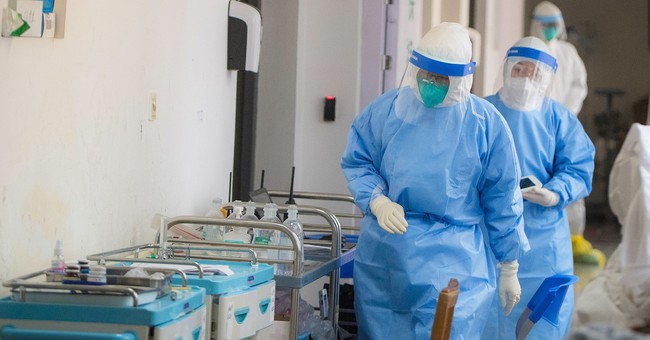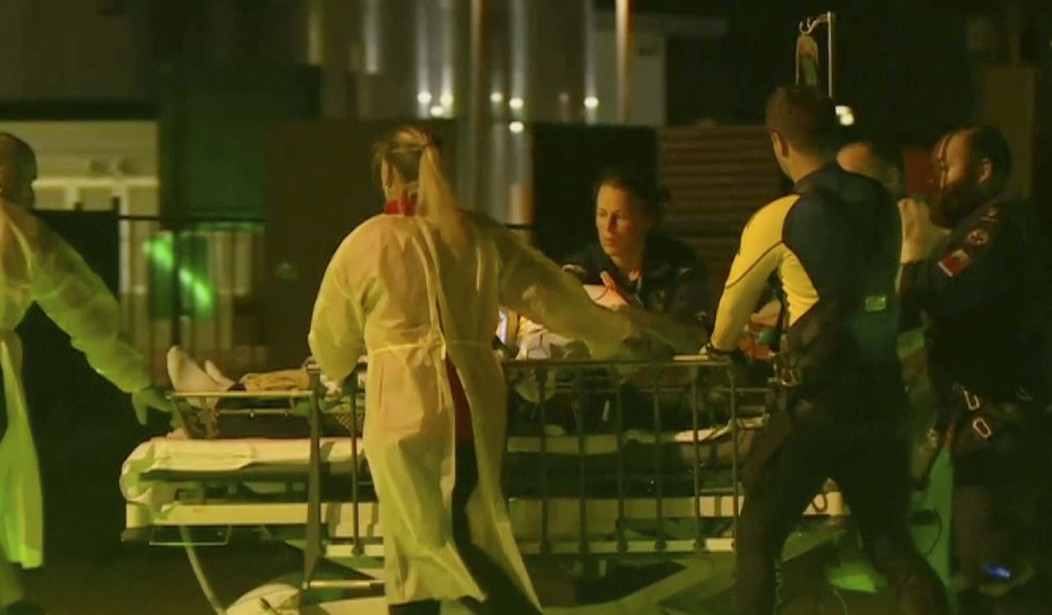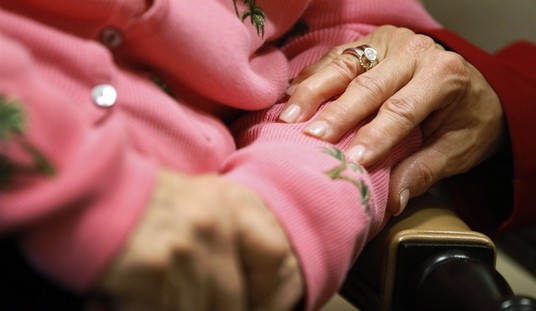
Well, it looks like those of us who were skeptical about the threat COVID-19 poses were wrong and it really has started to overwhelm our medical system.
Researcher Justin Hart posted a Twitter thread a few days ago citing news of hospitals across America barely able to cope with the surge in patients.
But not to worry. They found creative ways to handle it and nobody’s died for lack of care.
The head of family medicine at New Jersey’s Robert Wood Johnson Medical Center, Dr. Alfred Tallia said:
“[We’re] ‘managing, but just barely,’ at keeping up with the increased number of sick patients in the last three weeks. The hospital’s urgent-care centers have also been inundated, and its outpatient clinics have no appointments available.”
"Tallia says his hospital is 'managing, but just barely,' at keeping up with the increased number of sick patients in the last three weeks. The hospital’s urgent-care centers have also been inundated, and its outpatient clinics have no appointments available.”
3/— Justin Hart (@justin_hart) July 9, 2020
Wait. Sorry. My bad.
At the end of the thread, Hart reveals that the quote is from 2018. A web search indicates it came from a Time Magazine story reporting that the seasonal flu was overrunning our medical system and explaining what hospitals were doing to handle it back then.
Somehow, they managed to deal with the surge in flu patients two years ago without it dominating the national news, driving everyone into a panic, or imposing any kind of a lockdown.
Huh? Who would have thought it?
Moreover, it wasn’t just New Jersey.
Time reported that Alabama’s medical system experienced a huge surge in flu patients in 2018 as well. But, amazingly, somehow they also managed to make sure nobody died from lack of treatment without wrecking the economy or driving any psychologically struggling people to suicide by cruelly depriving them of human companionship.
“Dr. Bernard Camins, associate professor of infectious diseases at the University of Alabama at Birmingham, says that UAB Hospital cancelled elective surgeries scheduled for Thursday and Friday of last week to make more beds available to flu patients. “We had to treat patients in places where we normally wouldn’t, like in recovery rooms,” says Camins.”
“We had to treat patients in places where we normally wouldn’t, like in recovery rooms,” says Camins. “The emergency room was very crowded, both with sick patients who needed to be admitted”
5/— Justin Hart (@justin_hart) July 9, 2020
“In California… several hospitals have set up large “surge tents” outside their emergency departments to accommodate and treat flu patients.” Even then, the LA Times reported this week, emergency departments had standing-room only, and some patients had to be treated in hallways.”
"In CA… several hospitals have set up large 'surge tents' outside their emergency departments to accommodate and treat … patients. Even then, the LA Times reported this week, emergency departments had standing-room only, and some patients had to be treated in hallways.”
6/— Justin Hart (@justin_hart) July 9, 2020
And the 2018 flu wasn’t just a problem in New Jersey, Alabama, and California. Time also reported that Missouri experienced a surge in flu cases. Yet, once again, they found ways to handle it that didn’t involve killing lots of people with other ailments by making them too afraid to leave their homes for treatment.
In Fenton, Missouri, SSM Health St. Clare Hospital has opened its emergency overflow wing, as well as all outpatient centers and surgical holding centers, to make more beds available to patients who need them. Nurses are being “pulled from all floors to care for them,” says registered nurse Jennifer Braciszewski. “Almost every patient in the hospital has the flu, and it’s making their pre-existing conditions worse,” she says. “More and more patients are needing mechanical ventilation due to respiratory failure.”
“it’s making their pre-existing conditions worse,” she says. “More and more patients are needing mechanical ventilation due to respiratory failure”
8/— Justin Hart (@justin_hart) July 9, 2020
The Los Angeles CBS affiliate also reported that California experienced a surge of flu patients in 2018. But instead of driving Americans successfully struggling with chemical dependency back to booze or drugs by depriving them of the salvation of a daily routine, another strategy they used was diverting patients to hospitals that weren’t hit so hard.
“From Laguna Beach to Long Beach, emergency rooms were struggling to cope with the overwhelming cases of influenza and had gone into “diversion mode,” during which ambulances are sent to other hospitals. O.C. Global, one of Orange County’s busiest hospitals, announced Thursday afternoon it would no longer be accepting ambulances at its emergency room, except for those transporting trauma patients. “It’s not just Orange County, it’s all across the country,” internist Dr. Ray Casciari with St. Joseph Hospital told CBS2 News. “So, yes, this is going to be an epidemic year,” Casciari warned.”
“Hospitals across the state are sending away ambulances, flying in nurses from out of state and not letting children visit their loved ones for fear they’ll spread… Others are canceling surgeries and erecting tents in their parking lots to triage the hordes of… patients.”
10/— Justin Hart (@justin_hart) July 9, 2020
Funny how this surge in flu cases didn’t dominate the news in 2018. But the Los Angeles Times also reported on California’s hospitals being overrun that year; as well as other creative ways they managed to avoid having anyone die from lack of care without drastically increasing the number of children who suffered sexual abuse by locking them down with drunk and angry relatives unable to earn a living.
“Hospitals across the state are sending away ambulances, flying in nurses from out of state and not letting children visit their loved ones for fear they’ll spread the flu. Others are canceling surgeries and erecting tents in their parking lots so they can triage the hordes of flu patients. “Those are all creative things we wouldn’t typically do, but in a crisis like this, we’re looking at,” said Michelle Gunnett, a nurse who oversees emergency services for a Southern California hospital system. Staff members at Torrance Memorial Medical Center have been working long hours to care for a swell in sick patients that began in late December, said Dr. James McKinnell, infectious disease specialist. Some patients are incredibly ill with multiple strains of the flu, or the flu and pneumonia. “There’s a little bit of a feeling of being in the trenches. We’re really battling these infections to try to get them under control,” McKinnell said.”
“There’s a little bit of a feeling of being in the trenches. We’re really battling these infections to try to get them under control,” McKinnell said. “We’re still not sure if this is going to continue … “
11/— Justin Hart (@justin_hart) July 9, 2020
“At Parkland Memorial Hospital in Dallas, waiting rooms turned into exam areas as a medical tent was built in order to deal with the surge of patients. A Houston doctor said local hospital beds were at capacity, telling flu sufferers they might be better off staying at home. Austin’s emergency rooms have also seen an influx of flu patients. But high emergency room volumes and filled hospital beds are “not uncommon” for this point during flu season”
"At Parkland Memorial Hospital in Dallas, waiting rooms turned into exam areas as a medical tent was built in order to deal with the surge of patients. A Houston doctor said local hospital beds were at capacity”
12/— Justin Hart (@justin_hart) July 9, 2020
Chicago local news reported that their hospitals were also overrun by the flu in 2018. But, as hard as it is to believe, instead of causing a lot of additional hardship, misery, and death by shutting the city down, they asked the public to avoid going to the hospital for non-emergencies.
“Dr. Anthony Marinelli says they’ve seen a major spike in influenza cases. It’s so overwhelmed the community hospital that they’ve gone on bypass at times — that means they tell ambulances to bypass this ER and find another. “In a flu epidemic, so many patients can get the flu it’s going to strain medical resources which is why you’re asking the public only go to the hospital if you’re having severe symptoms. Can’t eat, can’t drink, can’t breathe, those kind of symptoms,” Dr. Marinelli said.”
“Dr. Anthony Marinelli says they've seen a major spike in… cases. It's so overwhelmed the community hospital that they've gone on bypass at times — that means they tell ambulances to bypass this ER and find another.”
13/— Justin Hart (@justin_hart) July 9, 2020
“Dr. Atallah, the chief of emergency medicine at Grady [Hospital in Atlanta], says the hospital called on a mobile emergency department based nearly 250 miles away to help tackle the increasing patient demand. “At 500-plus patients a day you physically just need the space to put a patient in. “
“Dr. Atallah, the chief of emergency medicine at Grady, says the hospital called on a mobile emergency department based nearly 250 miles away to help tackle the increasing patient demand. "At 500-plus patients a day you physically just need the space to put a patient in. “
14/— Justin Hart (@justin_hart) July 9, 2020
It sure is a shame nobody remembered that the flu overwhelmed our hospital system just two years ago or any of the simple and creative strategies that were used to make sure everybody got the treatment they needed without flagrantly violating the oath every doctor takes to “first, do no harm.”
Especially since our hospitals haven’t been overrun by COVID-19 anywhere near to the extent that they appear to have been in 2018 by the flu. Quite the reverse. We wound up with an historically unprecedented number of empty beds these past few months. Health care workers are being furloughed, and, almost unbelievably, the crisis we’re facing is a wave of medical facilities in danger of having to close down for lack of patients.
Wonder why an expert like Fauci didn’t know about any of this?
Maybe somebody ought to ask him.
Preferably behind bars after reading him his Miranda rights.













